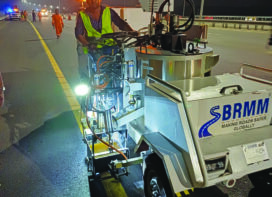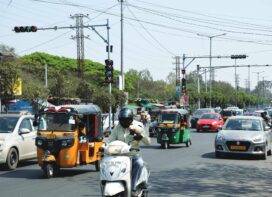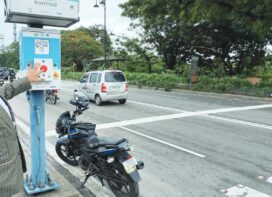Li-Fi
The development of Wi-Fi within rail and metro within transit is well documented and is a service offered on many trains and at stations around the world. But a new technology, Li-Fi, could well soon supersede it and become the future of mobile internet. Li-Fi, transmits data using the spectrum of visible light and many experts claim this leads to reduced costs and greater efficiency to traditional Wi-Fi. Wi-Fi and Li-Fi both transmit data over the electromagnetic spectrum, but whereas Wi-Fi uses radio waves, Li-Fi uses visible light. As visible light is far more plentiful than the radio spectrum it is believed it can achieve far greater data density and provide a better service.
This technology is appealing for metros not only for the opportunity it offers passengers to better access web-based material and enjoy a greater array on on-board or at-station infotainment but also from an operational point of view as Li-Fi by not using radio frequencies poses no risk of interfering with mission critical electronic circuitry. This is still a developing technology and questions still remain over line of sight and issues of delivery but if executed fully can offer a major opportunity.
Big Data and rail
A major buzzword for many industries but a development with real potential for the rail and metro industry. Big Data, defined here as a massive volume of both structured and unstructured data that is so large that it’s difficult to process using traditional techniques. The harvesting of such data has two major areas of potential for rail and metro. Smarter train communication through wireless signaling enables operators to constantly receive data from trains and more effectively monitor performance and highlight potential problems or maintenance requirements in advance. This can diminish the time for which trains are out of operation and limit disruption to passenger service.
In addition, the development of smartcards and CRM systems have enabled operators to gather a huge amount of data of their passengers for the first time. This enables operators to gain a deeper insight into behavioral and movement patterns and make smarter and more efficient choices accordingly. Not only on an operational level e.g. staff deployment or passenger on station flow management but also in improving customer service and making marketing more targeted.
Ticketless Travel
A number of solutions are now available for the use of bank cards acting as ticketless solution on rail and metro including EMV band cards (Euro pay, MasterCard and Visa), and Barclay card’s Pay Tag stickers.
Many commentators see the main development in ticketless travel coming from smartphones eventually replacing completely the need for season tickets and smartcards with NFC (Near Field Communication) technology already built into many smartphones and not being deployed.
As an example, Transport for London (TfL) offers its underground passengers the opportunity to use their bank cards for ticketless travel and is currently the strongest development in this sector from one of the most influential operators. Passengers on buses in London already use their bank card instead of the smartcard or cash.
The technology is very attractive to operators as not only do they maintain a stored value, so the operator has your money before your travel but they can also be read very quickly at barriers and gates and help to build up a significant data picture. No doubt the technology will soon be able to answer these questions though.
High-Speed and Hyper-Speed Rail
High-speed rail has already revolutionized national and international transportation in many parts of the world, particularly in Japan, China and continental Europe. And now plans are being developed to move even faster. The United Kingdom or California is familiar to the world of hyper-speed rail travel.
‘Hyperloop’, an innovative new form of transportation, consists of an elevated, reduced-pressure tube that contains pressurized capsules driven within the tube by a number of electric motors. It is claimed to be immune to weather, zoom twice as fast as an airplane, four times as fast as a bullet train, and to top it off operate completely on solar power. Whilst the Hyperloop may currently lack the financial or political will to make it a reality, there’s no doubt that super high-speed rail shall be on the anvil sooner than later.
In China, the Shanghai Maglev Train has been in operation since 2003 and has been recorded at a top speed of 311mph, Japan’s famed bullet train, the Shinkansen runs on a high-speed network of over 1400 miles hitting speeds of up to 275mph and in Europe, France’s TGV Réseau which generally runs at 199mph has been serving passengers since 1992. The slow but continued growth of High-Speed rail not only opens up a host of further technical developments but offers a strong countermeasure to other forms of transport.
Ergonomic station design
With passenger numbers generally increasing and demands and expectations changing, the modern train station is changing and offers a host of potential developments for passengers. Ensuring that large numbers of travelers can move freely and efficiently to, through and from a station is essential to maintaining the operational effectiveness of the transport system as a whole.
Station developments now consider ergonomic and human factors, in particular looking in a scientific way at people and their needs, and then providing analytical evidence based on psychological, behavioral and physical factors to improve experiences. For example, in the development of stations, experts can be used to analyze passenger movement and behavior and then plan the station layout to encourage them to do the things you need them to do, for example travelling on the correct side of the escalator or arriving at gate lines with the tickets ready. Some other areas that provide growth opportunities in this sector include the development of new technologies and smart ticketing and also the place for retail and catering establishments within the station.
Coupled with Big Data and Smart Ticketing, ergonomic station design could create a new and improved passenger experience at a station.
 TrafficInfraTech Magazine Linking People Places & Progress
TrafficInfraTech Magazine Linking People Places & Progress


